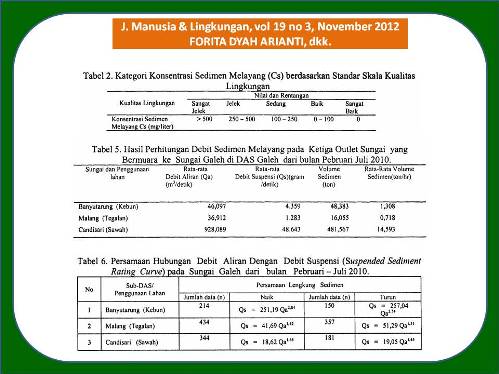
DAMPAK PENGELOLAAN LAHAN PERTANIAN TERHADAP HASIL SEDIMEN DI DAERAH ALIRAN SUNGAI GALEH KABUPATEN SEMARANG (The Impact of Agriculture Land Management to The Sediment Yield in Galeh Watershed Semarang District)
Forita Dyah Arianti(1*), Suratman Suratman(2), Edhy Martono(3), Slamet Suprayogi(4)
(1) UGM
(2) UGM
(3) UGM
(4) UGM
(*) Corresponding Author
Abstract
ABSTRAK
Perubahan jumlah manusia dan bentuk kegiatannya akan mengakibatkan perubahan dalam pengelolaan lahan. Sistem pengelolaan lahan pertanian pada daerah aliran sungai (DAS) Galeh umumnya masih belum memperhatikan kemampuan dan kesesuaian lahan. Masyarakat yang bermukim di DAS Galeh didominansi oleh petani. Dinamika pengel laan lahan pada sistem DAS akan mempengaruhi kondisi aliran sungai, yang menyebabkan terjadi perubaban debit aliran sungai sebagai keluaran DAS, sehingga mengakibatkan perubahan dalam kualitas lingkungan. Dampak yang sering terlihat adalah terjadinya kerusakan lahan karena meningkatnya erosi tanah dan sedimentasi. Kajian ini dilakukan dari bulan Pebruari sampai bulan Juli tahun 2010 di DAS Galeh, Kabupaten Semarang dengan tujuan untuk mengetahui hasil sedimen yang diakibatkan oleh pengelolaan lahan pertanian yang berbeda di daerah aliran sungai Galeh. Kajian dilakukan dengan cara menganalisis sampel-sampel sedimen melayang (suspended sediment) yang diambil dari outlets ketiga sungai utama yang bermuara ke Sungai Galeh. Parameter-parameter yang diukur untuk keperluan analisis hasil sedimen ini, yaitu konsentrasi sedirnen melayang Cs (mg/l), debit aliran air sungai Q (m3/detik) dan debit sedimen melayang Qs (gr/detik). Dari hasil kajian tampak bahwa terdapat debit aliran yang berpengaruh terbadap debit suspensi, di mana semakin besar debit aliran maka semakin besar debit suspensi. Pengelolaan lahan sawah memiliki debit aliran dan debit suspensi yang lebih tinggi dibanding pengelolaan lahan kebun dan lahan tegalan. Sedimen yang dihasilkan pada pengelolaan lahan sawah sebesar 14,593 ton/hari; pengelolaan lahan kebun sebesar 1,308 ton/hari, pengelolaan lahan tegalan sebesar 0,718 ton/hari.
ABSTRACT
The change of the number of people and the activity type will cause a change in cultivation land. Agriculture land cultivation system in Galeh Watershed (DAS) generally still has not pay attention to the ability and appropriate land. The residents who stay in DAS Galeh are dominated by farmer. The dynamics of cultivation land on the DAS system will influence the river current condition, which causing the change of river current debit occurred as output of DAS, thus result in the change in environment quality. Impact that often observed is occurred damage of land because the increased of land erosion and sedimentation. This study was done from February until July 2010 in DAS Galeh, Semarang District, aimed to know the sediment result which caused by different cultivation of agriculture land in the river current area Galeh. The study conducted with the methods is analyzing samples of suspended sediment that taken from outlets of the third main river which flow into downstream Galeh river. The parameters measured to analyze requirements of this sediment result, were concentration of suspended sediment Cs (mg/l), discharge debit Q (m3/second) and discharge of suspended sediment debit Qs (gram/second).The result of the study is showed that there is current debit which affecting the suspension debit, whereas greater the current debit thus greater the suspension debit. Cultivation land of rice field is 14.593 ton/day; cultivation land of plantation is 1.308 ton/day, cultivation land of garden is 0.718 ton/day.
Keywords
Full Text:
Artikel lengkap (PDF) (Bahasa Indonesia)Article Metrics
Refbacks
- There are currently no refbacks.
Copyright (c) 2017 Jurnal Manusia dan Lingkungan







